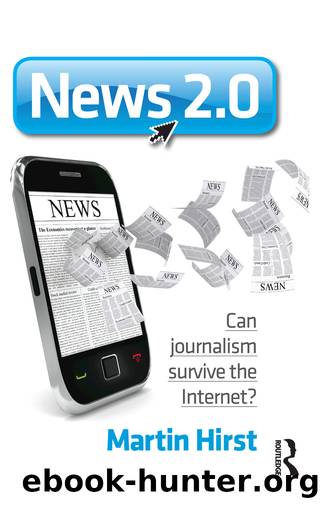News 2.0 by Martin Hirst

Author:Martin Hirst [Hirst, Martin]
Language: eng
Format: epub
Tags: Computers, Internet, General, Language Arts & Disciplines, Journalism
ISBN: 9781742370576
Google: ITRTnwEACAAJ
Publisher: Allen & Unwin
Published: 2011-01-15T03:51:13+00:00
Amateurism, political economy and exploitation
. . . the less appealing side of this amateurism is the cut-price labor economy it has established as the default mentality of the cyberworld, where sacrificial labor and self-exploitation are the order of the day.
Andrew Ross
There is another factor to consider in relation to amateurism in the news industry. It is one thing to argue that this is journalism from below, but the logic and dynamic of capitalism means that there will be seriousâ and probably successfulâattempts to incorporate amateurism into the mainstream news mediaâs value chain. In terms of the political economy of amateurism, Andrew Ross (2009) has argued that it in fact creates new conditions for exploitation of labour and a potential new channel of surplus value and profit for the mainstream media. Ross points out that contestants on reality TV shows often âworkâ long hours for little or no pay under poor conditions and that when writers on the syndicated reality show Americaâs Got Talent wanted to join a union they were fired. New York Universityâs Sue Collins (2008) also points out that the huge global growth of reality television has displaced a highly unionized and professional workforce in Hollywood and is moving the industry towards a âflexibleâ profit and cost model. Ross makes the point that these changes have occurred in sections of the âoldâ media that are âmost clearly aligned with the neoliberal ethos of the jackpot economyâ, but in the âworld of new media, where unions have no foothold, the formula of overwork and underpayment is entirely normativeâ (Ross, 2009).
Rossâs âThe political economy of amateurismâ is a short article, but it makes some very telling points about how exploitative the world of Web 2.0 can beâfor example, social network users signing away the copyright on any materials they upload to Facebook or YouTube. For the corporate players, the avalanche of user-generated content uploaded to their servers âserves as the lucrative raw material for data mining, corporate market research, and entrepreneur hosts bent on getting bought outâ. In terms of a political economy of UGC, it is important to add amateur, alternative and citizen journalism and all forms of UGNC into this mixâperhaps not when content is hosted on independent sites, but certainly when it is uploaded to CNNâs iReport or to any other commercial website where it becomes the property of the host. As Ross points out, âthe outcome is a virtually wage-free propositionâ in which users, or âprosumersâ, as industry strategists call them, âcreate all the surplus valueâ (2009). In much the same way, the incorporation of crowdsourcing into news-gathering and reporting routines does much the same thing. This is not to suggest that further developments in digital technology and social media applications wonât alter journalistic practice even further, but it does imply that social media, crowdsourcing and collaborative production models will not replace mainstream news organizations or cause the total collapse of the news industry any time soon. Cheap labour and exploitative content farms are more likely to extend its life span.
Download
This site does not store any files on its server. We only index and link to content provided by other sites. Please contact the content providers to delete copyright contents if any and email us, we'll remove relevant links or contents immediately.
Asking the Right Questions: A Guide to Critical Thinking by M. Neil Browne & Stuart M. Keeley(5572)
Autoboyography by Christina Lauren(5154)
Eat That Frog! by Brian Tracy(4377)
Dialogue by Robert McKee(4270)
Sticky Fingers by Joe Hagan(4060)
Journeys Out of the Body by Robert Monroe(3535)
Annapurna by Maurice Herzog(3395)
Full Circle by Michael Palin(3346)
Schaum's Quick Guide to Writing Great Short Stories by Margaret Lucke(3278)
Elements of Style 2017 by Richard De A'Morelli(3278)
The Art of Dramatic Writing: Its Basis in the Creative Interpretation of Human Motives by Egri Lajos(2944)
Why I Write by George Orwell(2849)
The Diviners by Libba Bray(2839)
In Patagonia by Bruce Chatwin(2828)
The Mental Game of Writing: How to Overcome Obstacles, Stay Creative and Productive, and Free Your Mind for Success by James Scott Bell(2816)
The Fight by Norman Mailer(2792)
Atlas Obscura by Joshua Foer(2757)
Venice by Jan Morris(2494)
The Elements of Style by William Strunk and E. B. White(2413)
